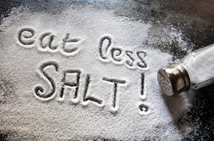6. Salt
Salt usually refers to sodium chloride. Sodium is a mineral that you need for optimal body function. It is essential for maintaining the right balance of body fluids, transmitting nerve impulses, and controlling muscle contraction and relaxation.
Sources
 While many foods (such as whole grains, meat and dairy products) naturally contain trace amount of sodium, the main source of sodium is salt which usually serves as seasoning or preservative, or sodium sources that come in various forms such as monosodium glutamate (MSG) and baking soda. Processed meats such as ham, sausages, bacon and other preserved meat may contain from 3-5 grams (g) of salt per 100 g. Some savoury snacks, breads, canned soups, breakfast cereals also contain substantial amounts of salt; anything from 1 to 4 g per 100 g. Besides, traditional Asian condiments, including oyster sauce, fish sauce and prawn paste, are usually high in salt too.
While many foods (such as whole grains, meat and dairy products) naturally contain trace amount of sodium, the main source of sodium is salt which usually serves as seasoning or preservative, or sodium sources that come in various forms such as monosodium glutamate (MSG) and baking soda. Processed meats such as ham, sausages, bacon and other preserved meat may contain from 3-5 grams (g) of salt per 100 g. Some savoury snacks, breads, canned soups, breakfast cereals also contain substantial amounts of salt; anything from 1 to 4 g per 100 g. Besides, traditional Asian condiments, including oyster sauce, fish sauce and prawn paste, are usually high in salt too.
Requirement
For healthy adults, the World Health Organization (WHO) and the Food and Agricultural Organization (FAO) of the United Nations recommend sodium consumption of less than 2 000 milligrams (mg) a day. As salt is composed of 40% sodium and 60% of chloride, this equals to 5 000 mg or approximately one teaspoon of salt. Children should have less salt than adults. The younger the child, the lesser amount of sodium he/she requires a day.
Health AlertEating too much sodium can increase blood pressure, which in turn increases the risk of stroke, coronary heart disease, heart failure and renal disease. |
Practical Tips for Reducing Salt Intake
Salt is placed at the "Eat the Least" level at the top of the Food Pyramid. They should be taken in small amounts. Here are some suggestions for keeping your salt intake in check:

- use fresh food where possible when making home-made meals;
- limit intake of salt preserved foods, such as processed meat, salted eggs, instant noodles, canned soup or pickled vegetables;
- use herbs and spices instead of salt to add flavour to dishes, such as garlic, pepper, lemon juice or vinegar;
- replace ready-to-use sauces with sauces made with fresh ingredients, such as lemon, tomato, pepper, pumpkin and spinach;
- cut down the amount of salt and sauces (e.g. soy sauce or oyster sauce) used in cooking and avoid adding them at the table;
- rinse pickled or canned vegetables in boiling water before cooking to remove excessive salt or avoid them entirely;
- replace crisps, crackers or other salty snacks with low-salt alternatives, such as fresh fruit, unsalted nuts and boiled corn (served without butter or margarine);
- choose foods prepared with more natural seasonings and less sauce when eating out, and ask to have the sauce served separately;
- read nutrition labels to check the amount of salts contained in the prepackaged foods and select lower salt options.
References
Diet, Nutrition and the Prevention of Chronic Diseases: Report of a Joint WHO/FAO Expert Consultation. WHO Technical Report Series No. 916.Geneva: World Health Organization; 2003.
Food, Nutrition, Physical Activity, and the Prevention of Cancer: a Global Perspective. Washington DC: World Cancer Research Fund and American Institute for Cancer Research; 2007.
Chinese DRIs. Chinese Nutrition Society.




































